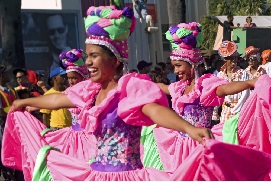Santo Domingo, the capital of the beautiful Dominican Republic, was destroyed by a hurricane in 1502, but then over the centuries this Spanish colony erected large public, private and religious buildings, being as it was the administrative center of the New World and one of the great cities of the Americas. In 1990 its Colonial Zone was included on the UNESCO World Heritage List.
· Baluarte del Conde: a collection of defensive buildings with many historical items: the park known as Parque de la Independencia, the Puerta de la Misericordia and Puerta del Conde gates, the Fort of La Concepción and the Altar of the Fatherland.
· Cathedral of Santo Domingo: The Primary Cathedral of America. Consecrated in 1504, it is next to the Parque de Colón. During some time it contained some of the remains of Christopher Columbus (there are several places claiming the same honor), which were subsequently transferred to the Museum dedicated to the famous sailor, known as the Faro de Colón.
· Alcázar de Colón or Palacio Virreinal de Don Diego Colón. This fortress or palace was erected on the land that King Ferdinand the Catholic donated to the son of Christopher Columbus in order for him to build his residence, today it houses the Alcázar Museum. It was built in the Mudejar style, using coral stones from the area, and it included over 55 rooms (of which just over 20 remain today).
· Parque de Colón is the ancient Main Square of the colonial period.
· Ozama Fortress, built by the Spaniards during the years of the conquest, between 1502 and 1508. On the banks of the Ozama River, it is the oldest fortress in the Americas. It was erected to protect the city from attacks by the pirates and the English, French and Portuguese forces. It provided a vantage point over the mouth of the Ozama River and the Caribbean coastline.
· National Pantheon: During the 18th century it was a Jesuit monastery, which then passed into the hands of the Spanish Crown, after which it was used as a warehouse to store tobacco. In 1955, Trujillo decided to make it a Monument to the Heroes of the Nation.
· Museum of Modern Art: This is considered one of the best museums of modern art of Latin America. It has a large collection of contemporary Dominican art filled with fresh, lively, high quality works.
· Museum of the Dominican Man: One of the most important museums of the Dominican Republic, with many priceless items of Pre-Columbian art. This museum takes us back to the history of the ancient dwellers of Santo Domingo, the Taínos. You can see ceramics, clothing and ancient art of the first peoples dwelling on the island of Hispaniola.

